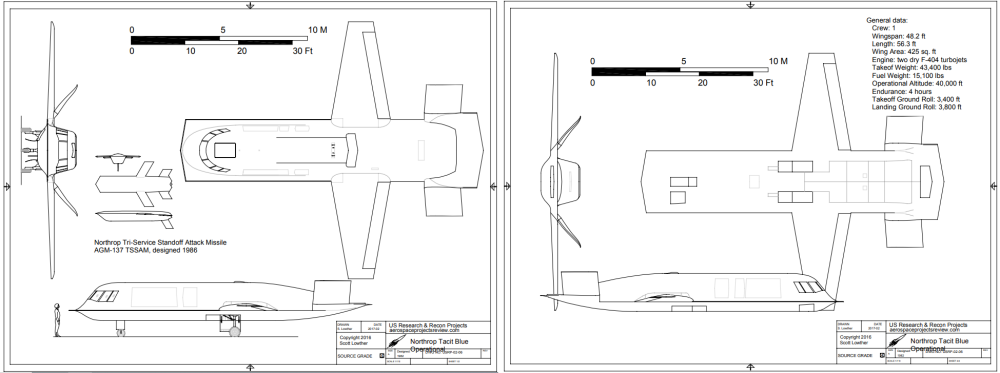Bondo Gave The Secret Tacit Blue Demonstrator Jet Its Smooth Stealthy Skin
Veteran Northrop engineer recollects his time on the top-secret Tacit Blue program, including some of its oddest quirks.
By Brett Tingley and Tyler Rogoway
February 20, 2022
In the late 1970s, the Pentagon saw a need for a new class of battlefield surveillance aircraft that could penetrate into denied airspace and collect intelligence in real-time for long periods by using a new technology that was beginning to emerge known as stealth. With this in mind, the U.S. Air Force and the Defense Advanced Research Projects Agency approached the Northrop Corporation, which had some experience with stealth technology already, to build a reconnaissance aircraft built around an advanced radar system. The resulting prototype aircraft was known as Tacit Blue, now regarded by the Air Force as one of the most successful technology demonstrators ever funded.
To shed light on the history of the Tacit Blue Project, the Western Museum of Flight in Torrance, California hosted veteran Northrop aerospace engineer Don Murray last year. The museum’s director introduced Murray as “a key player in the development of highly stealthy technology” and “widely recognized among the pioneers of stealth.”[...]
[...]Murray was assigned to be a second shift supervisor for the Tacit Blue project, which grew out of an Air Force and Defense Advanced Research Projects Agency (DARPA) initiative known as the Battlefield Surveillance Aircraft-Experimental (BSAX) program. That program was aimed at producing a technology demonstrator aircraft that combined the battlefield survivability aspects of a low-observable stealth aircraft with a low probability of intercept (LPI) radar and data-link suite[...]
[...]When he joined the program, the basic airframe had been completed and assembled. Murray explained that the wings and fuselage of the demonstrator were constructed out of a standard aluminum alloy, while the radar-sensitive empennage and leading edges of the wings and fuselage/chines being built from a “proprietary Northrop composite material” that was key to the aircraft's stealthiness.[...]
[...]The program encountered few problems during pre-flight development, but Murray explained how the team had difficulty “attaining the smoothness and curvature on the fuselage to satisfy low observable requirements.” To remedy this, Northrop engineers turned to Bondo, a plastic-based auto body filler commonly found in auto parts stores.[...]
[...]The program worked under strict sight sensitivity controls, meaning the AP-1 demonstrator had to be hidden from view when not performing tests that required it to be moved outdoors at Area 51. “The program was highly classified,” Murray said. “The vehicle was sight-sensitive.[...]
[...]To protect the aircraft from being seen, Murray said that most of the ground testing was performed inside a hangar. “We even did low- and high-power engine runs inside the hangar.[...]
[...]During these ground tests, the team discovered that it was impossible to start the AP-1’s Garrett ATF3 engines without starting them both at the same time. Because both turbofan jet engines shared a common intake without a splitter and were mounted side-by-side, any attempt to start the engines one at a time would fail due to the first engine “hogging up all the air,” Murray said. [...]
[...]To remedy this, Murray’s team developed what they called the “Almost Simultaneous Start, with the appropriate acronym,” according to the veteran engineer. “We’d get the first engine cranking, and before it lit off, we’d crank the second engine. So they more or less lit off and spooled up to idle speed at the same time.”[...]
[...]Once these ground tests were completed, the Tacit Blue flight test program began. Missions were conducted at Area 51 from February 1982 until June 1985 and consisted of over 140 sorties totaling 250 hours.[...]
[...]Now-retired Lt. Gen. George K. Muellner, who served as principal deputy assistant secretary of the Air Force for Acquisition, stated at the Tacit Blue’s unveiling that the program “turned into a test-bed because its low-observable technologies proved to be more valuable than its [mission] contribution.[...]
[...]Still, there were concerns that an operational version of the Whale would be limited to nighttime missions due to its visual signature. For this specific role of tracking large armored columns and Soviet troop movements, it was also an issue that an operational but still secret Tacit Blue offspring's intel would have been so good that anyone who saw it would wonder where it came from and the asset's existence would have been realized fairly quickly. In other words, it was too effective to regularly use and integrate into standard operations while maintaining any modicum of secrecy. [...]
[...]Ultimately, Tacit Blue remains one of the most ambitious and influential aircraft development programs in history, proving that even a 'Whale' sporting a giant radar can take to the skies and remain there undetected.[...]

















